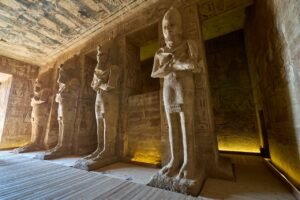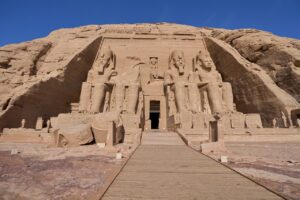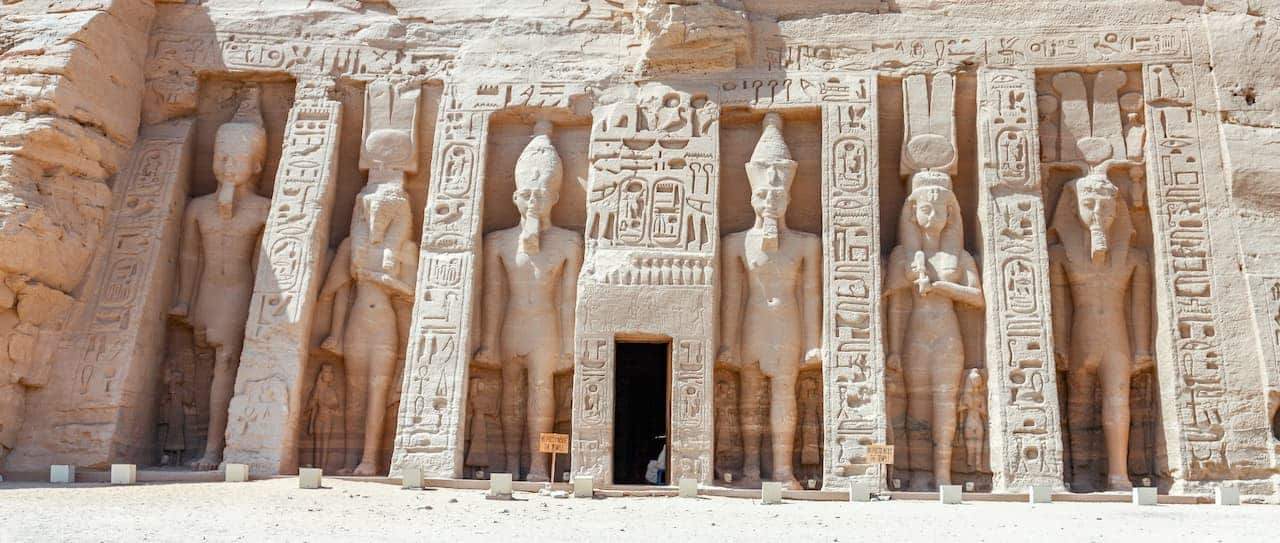Abu Simbel: The Temples That Moved
Abu Simbel: The Temples That Moved For A Dam
Are you curious about the remarkable engineering feat behind Abu Simbel, commonly known as “The Temples That Moved”? These ancient structures were impressively relocated in 1964 to make way for the High Aswan Dam.
In this article, we will delve into the captivating history, intricate details, and the painstaking process of moving these legendary temples. Prepare for a journey back in time that will unleash Egypt’s magnificent past before your eyes.
History of Abu Simbel Temples 
Ramses II constructed the Abu Simbel Temples, which were eventually rediscovered and relocated in 1964.
Construction by Ramses II
Ramses II, the pharaoh of Egypt in the 13th Century BC, commissioned the construction of Abu Simbel. Esteemed by many as one of his most grandiose projects, it took two decades to complete.
Notably, there are two temples at this complex – both meticulously carved out from solid rock formations over the years. All around, people marvel at their artistry and precision, reflecting Ramses II’s ambition to leave a lasting legacy.
Artisans sculpted each block carefully with intricate details prevalent across every inch of these magnificent structures. These magnificent feats highlight the architectural prowess of Ramses II’s reign in ancient Egypt.
Rediscovery
Archaeological wonders often lie hidden, waiting to be rediscovered by the modern world. Such was the case with the magnificent Abu Simbel temples. These ancient structures, built by Pharaoh Ramses II in the 13th century BC, were lost for centuries until their grandeur was unveiled once again.
It wasn’t until the early 19th century that these rock-cut temples were stumbled upon by explorer Giovanni Belzoni. With his discovery, vintage photographs captured the stunning sight of these architectural marvels buried beneath sand dunes and forgotten over time.
The resurrection of Abu Simbel marked a pivotal moment in Egyptian archaeology, as it sparked an interest in historical preservation and spurred efforts to protect other ancient monuments from being lost to history’s depths.
Relocation in 1964
The Abu Simbel temples underwent a remarkable relocation in 1964 due to the construction of the High Aswan Dam. These ancient marvels, built during the reign of King Ramses II in the 13th century BC, were carefully dismantled and moved to a new desert plateau located 64 meters above and 180 meters west of their original site.
The entire project cost about SEK 200 million and was concluded on September 22, 1968, with a grand inaugural ceremony. This impressive feat allowed for the preservation of these historic treasures for future generations to admire.
The Great Temple
The Great Temple at Abu Simbel showcases exquisite exterior and interior features, including massive stone carvings of Pharaoh Ramses II, intricate hieroglyphics, and grand statues of gods.
Exterior and interior features
The Abu Simbel temples showcase stunning exterior and interior features that have captivated visitors for centuries. On the outside, these rock-cut structures boast intricate carvings depicting scenes from ancient Egyptian mythology and historical events.
The colossal statues of Pharaoh Ramses II guard the entrance to the Great Temple, standing at a height of 20 meters. Inside, visitors are greeted by grand halls adorned with magnificent wall reliefs depicting the pharaoh’s military victories and divine offerings.
Every detail, from the carefully carved columns to the beautifully painted ceilings, reflects the exquisite craftsmanship of ancient Egypt. The temples’ remarkable blend of architectural precision and artistic beauty truly make them an awe-inspiring sight to behold.
Solar alignment
The Abu Simbel temples boast a fascinating solar alignment, showcasing the remarkable astronomical knowledge of the ancient Egyptians. The Great Temple, dedicated to Ramses II, is designed in such a way that twice a year, on February 22nd and October 22nd, the sun’s rays penetrate through the entrance and illuminate three out of four statues inside.
One statue remains in darkness: Ptah, the god of darkness and fertility. This alignment signifies important solar events – February 22nd marks Ramses II’s ascension to the throne, while October 22nd signifies his birthday and coronation day.
The precision involved in achieving this alignment is truly astonishing, considering it was built over three thousand years ago.
Another fascinating aspect is that despite being relocated due to the High Aswan Dam project in 1964, efforts were made to maintain its solar alignment during relocation. Engineers meticulously calculated how to position both temples so that they still receive sunlight at the designated times each year.
This successful preservation showcases not only their commitment to historical accuracy but also their profound understanding of celestial movements.
Preservation efforts
Preserving the Abu Simbel temples has been a significant undertaking. These efforts have ensured that these ancient structures are still standing today for visitors to admire and learn from.
The relocation project in 1964 was just one part of the overall preservation strategy, as it allowed the temples to be saved from the rising waters of Lake Nasser caused by the construction of the High Aswan Dam.
This involved dismantling each temple piece by piece and relocating them to a desert plateau 64 meters above and 180 meters west of their original location. The entire project cost about SEK 200 million, but it was worth every penny to protect these remarkable historical treasures.
The Small Temple
The Small Temple serves a significant purpose and boasts intricate architectural details. Read on to discover the hidden gems within this ancient masterpiece.
Purpose and significance
The Small Temple at Abu Simbel serves a significant purpose in ancient Egyptian history. Built alongside the Great Temple by Pharaoh Ramses II, this smaller temple was dedicated to the goddess Hathor and his wife, Nefertari.
It showcases exquisite rock-cut architecture and intricate sculptural details, symbolizing the pharaoh’s devotion to his loved ones. The Small Temple holds immense historical importance as it represents Ramses II’s commitment to honor not only himself but also those closest to him.
Its significance lies not only in its architectural beauty but also in what it symbolizes about the ruler’s personal relationships and beliefs.
Architectural details
The Abu Simbel temples are renowned for their exquisite architectural details. The Great Temple, dedicated to the gods Ra-Horakhty, Amun-Ra, and Ptah, features impressive exterior carvings.
Massive statues of Pharaoh Ramses II guard the entrance, standing at a height of 20 meters and wearing the double crown of Egypt. Inside the temple, there are stunning wall reliefs depicting scenes from Ramses II’s military victories and religious rituals.
Another notable feature is the solar alignment that occurs twice a year when sunlight illuminates three out of four statues in the sanctuary.
The Small Temple, dedicated to Queen Nefertari and Hathor, showcases intricate architectural elements as well. The facade features six colossal statues: four depict Ramses II, and two portray Nefertari.
The interior walls display vibrant paintings depicting scenes of royal life and religious ceremonies involving Queen Nefertari.
The Relocation Project
International collaboration and meticulous precision were required to successfully relocate the Abu Simbel Temples, making it an extraordinary feat in architectural and engineering history.
Find out how this monumental task was achieved.
International collaboration
Various countries came together to assist in the relocation project of the Abu Simbel temples. Engineers, archaeologists, and experts from around the world collaborated on this massive undertaking.
Their combined efforts ensured that these historic structures were carefully dismantled, moved, and reconstructed in their new location. The international collaboration showcased the importance of preserving ancient monuments and highlighted the global significance of the Abu Simbel temples.
Challenges and precision involved
Relocating the Abu Simbel temples posed significant challenges that required immense precision. The temples had to be carefully dismantled and moved to a new location while ensuring their preservation and integrity.
This involved meticulous planning and coordination between international experts, engineers, archaeologists, and local authorities. The relocation project required the construction of a specially designed artificial mountain where the temples would be relocated.
Cranes were used to lift the massive stone blocks weighing up to 30 tons each. Every detail had to be meticulously documented and recorded in order to accurately reconstruct the temples in their new location.
Importance and Legacy of Abu Simbel Temples
The Abu Simbel temples hold immense importance and a lasting legacy in Egyptian history and culture. These magnificent structures, built over 3,000 years ago during the reign of King Ramses II, are considered one of the most impressive architectural wonders of ancient Egypt that still stand today.
Their grandeur and exquisite craftsmanship continue to captivate visitors from around the world.
These temples were not only a testament to Ramses II’s power but also served as symbols of his devotion to the gods. The Great Temple at Abu Simbel was dedicated to the gods Amun-Ra, Ra-Horakhty, Ptah, and Ramses himself.
It features colossal statues of Ramses II on its facade, showcasing his strength and authority as a pharaoh.
Another significant aspect is their alignment with solar events. Twice each year on February 22nd (Ramses’ ascension day) and October 22nd (his birthday), sunlight penetrates through the temple’s entrance corridor to illuminate three out of four statues inside – including one featuring Ramses himself – while leaving Ptah, the god associated with darkness in shadow.
Furthermore, these temples have also been recognized for their historical preservation efforts. In an unprecedented project spanning several years, starting from 1964, they were dismantled stone by stone before being moved further inland due to threats posed by Lake Nasser following the construction of the High Aswan Dam.
This international collaboration ensured these iconic monuments would be safeguarded despite rising waters along the Nile River.
Their relocation stands as a testament not just to human ingenuity but also highlights global cooperation in preserving cultural heritage sites for future generations. Today, Abu Simbel remains a UNESCO World Heritage Site attracting tourists who marvel at this marvelous example of rock-cut architecture set against stunning desert landscapes.
Facts About the Abu Simbel: The Temples That Moved
Ramesses II Commissioned the Temples to Display His Power
The ancient temples of Abu Simbel were commissioned by the powerful pharaoh Ramesses II, who ruled Egypt during the 19th dynasty from 1279 to 1213 BCE. He likely ordered the construction of the temples between 1264-1244 BCE, during the early part of his reign.
Ramesses II was known for his extensive building projects, and Abu Simbel intended to display his power as both a god and warrior king. The colossal scale of the rock-cut statues depicting Ramesses himself emphasizes his divine right to rule and control Egypt’s empire.
The Location was Strategically Chosen
The location chosen for the temples was a strategic decision by Ramesses II. They were built near the southern border of his empire, at a bend in the Nile River in what is now known as Lower Nubia. This region had been conquered by Ramesses early in his reign.
Situating these imposing temples of worship along the Nile was a political statement about Ramesses’ control over Nubia and dominion over his southern territories.
As the Nile was the highway for river trade and transportation, anyone sailing upstream would be able to see the massive facades from a distance as they rounded the river bend. The temples made it clear this was Ramesses’ domain.
The Great Temple Aligned with the Sun Twice a Year
The orientation and solar alignment of the Great Temple of Ramesses II was specifically planned as well.
This temple to the gods Ra-Horakhty, Ptah, and Amun was strategically constructed so that twice a year, on February 22 and October 22, the rays of the rising sun would penetrate the temple entrance and illuminate the carved shrine on the very back wall. All other areas remain in shadow at these times except for the very back of the inner sanctuary.
These dates may have held special meaning for Ramesses, perhaps corresponding with his birthday or coronation. Illuminating the temple’s inner shrine connected the pharaoh directly with the gods and reinforced his claim of divine birthright as a ruler.
The Temples Were Dismantled and Labeled Precisely
When the temples were relocated in the 1960s due to the flooding risk from the Aswan Dam, great care was taken to precisely dismantle and label the stone blocks so they could be reconstructed properly at the new site.
The larger temple was cut into 1,036 pieces, with each block weighing around 20-30 tons on average. The largest blocks were comparable in size to a school bus.
Each individual block was numbered and oriented so workers would know exactly where it fit into the original design.
Just the process of dismantling the massive temples, meticulously labeling each section, and preparing the giant stones to be moved took several years before reconstruction could even begin.
The New Site Required Modifying the Rock Face
At the newly elevated site, additional work had to be done to the existing cliff face before rebuilding could commence. Without modifying the rock surface, the original solar alignments within the Great Temple would not have worked.
Artisans had to cut away portions of the mountainside where the temple would stand, carving a facade from the new rock to match the angular recesses of the original temple front.
The small fissures and cracks of the sandstone cliff at the first site were also painstakingly recreated by workers at the new location. This allowed the reconstructed temples to blend seamlessly into the existing geology, appearing as if they had been carved in place centuries before.
Modern Technology Was Used to Document and Preserve the Site
In restoring Abu Simbel to its new location, modern technology played a key role in documenting and preserving the site.
Along with the detailed labeling system, engineers utilized the latest photographic techniques to carefully record the entire process for future generations. Scholarly analysis and archival records of the project provide valuable insights into ancient Egyptian architecture and construction methods.
Protective measures were also taken, including a state-of-the-art drainage system to channel rainwater runoff and help protect the sandstone facades from weathering and erosion. And for ongoing preservation, a concrete dome structure was erected over sections of the Great Temple to shelter it from the elements.
While the methods for dismantling and reconstruction relied on ancient engineering principles, modern technology was invaluable for recording this massive undertaking and protecting Abu Simbel for the future.
Conclusion
The Abu Simbel temples stand as a testament to both the grandeur of ancient Egyptian architecture and the ingenuity of modern preservation efforts. The relocation project was a true marvel, showcasing international collaboration and precision.
Today, these magnificent structures continue to awe visitors from around the world, serving as a reminder of Egypt’s rich history and cultural heritage.
FAQs
How were the Abu Simbel temples moved?
The Abu Simbel temples were carefully cut into blocks and relocated to higher ground by a team of archaeologists and engineers in the 1960s.
Why were the Abu Simbel temples moved?
The temples were moved to prevent them from being submerged by the rising waters of Lake Nasser due to the construction of the Aswan High Dam.
What is special about the Abu Simbel temples?
The Abu Simbel temples are known for their massive statues, intricate carvings, and historical significance as a testament to Ramses II’s power and achievements.
Can visitors enter the interior of the Abu Simbel temples?
Yes, visitors can explore the interior chambers of both temples, experiencing firsthand their grandeur and admiring ancient art and hieroglyphics preserved within.




